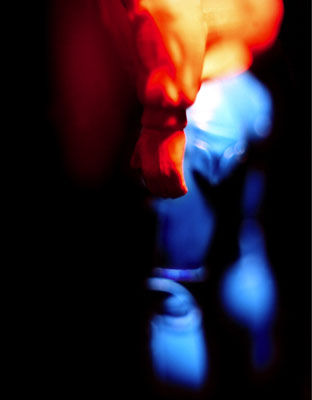KIMBER
Dissonant Melodies
Every trip to faraway places is inevitably accompanied by the tourist’s reflex; a desire to bring some aspect of the experience home in object form. With souvenirs (from the French for “remembering”) comes the small victory of ownership, but also, incompleteness, in possession of a paltry, mere replica of the original experience. The souvenir recharges the dead time, but only so far. What lingers is inchoate memory, which affirms that no totem will bring back the time it consolidates in material form.
Felicia Feaster, Art Papers, July 1999, page 7
At the edge of the night before the darkness became complete was the time when my father would read me fairy tales, I was four maybe five and these were the times when I felt close to him.
In the half light of twilight his frame would dominate the room. That shape loomed above me, an outline both inspiring and fragile. It took me years to understand that the image of masculinity I saw in my father was as much theatrical as it was real. The images here play with that mystery. They balance between my deeply felt desire to believe and participate in the theatre of masculinity that my father personified and the inevitable awareness that it was and still remains a trick of the light.
Imitating authority figures is a way of reducing demons to dolls, of shaping an outside world that for the rest of the day, is doing its best to shape us. All speech is an imitation of speech,-a parody and parody is best performed in a trance-like state pitched somewhere between attention and instinct. Successful parody lies in the centre of half belief and half disbelief. It must resonate between the two poles of scepticism and gullibility, if either pole topples, the joke caves in.
So in effect the theatre of photographic construction must occupy simultaneously the worlds of seduction and cynicism. Without the apparent beauty of the idealised there is little to compel us to commit. Without the awareness that we continually and willingly suspend disbelief and participate in these charades, there is the danger of complete surrender to a fantasy. It is vital to understand the two dimensional nature of these illusions but foolish not to acknowledge their power to beguile.
These are not fairy tales set in some medieval European wood, rather they occupy a more contemporary and cinematic space. They carry with them the resonance of a fantasy that shrouds experience at its core.
““It is characteristic of fairy tales to state an existential dilemma briefly and pointedly. This permits the child to come to grips with the problem in its most essential form, where a more complex plot would confuse matters for him. The fairy tale simplifies all situations. Its figures are clearly drawn; and details, unless very important, are eliminated. All characters are typical rather than unique. Contrary to what takes place in many modern children’s stories, in fairy tales evil is as omnipresent as virtue. In practically every fairy tale good and evil are given body in the form of some figures and their actions, as good and evil are omnipresent in life and the propensities for both are present in every man. It is this duality which poses the moral problem, and requires the struggle to solve it.” ”[1]
“The Glimpsed Distance” is a term used when discussing Medieval Architecture to describe a particular approach used in designing the layout of cities and towns. Streets were often positioned in such a way as to make it possible, wherever you went in that city, to see in the distance either the town hall or the church or the palace of your ruler. Even though they may be partially obscured, the town's layout made it difficult not to see these important buildings, thereby reassuring the populace of the ever-present nature of authority watching over them. Whether they liked it or not.
In the half-light of twilight, these images play with a mythical sense of masculinity underpinned by a nebulous atmosphere of eroticism. But in doing so at the same time they convey all the solidity of a mirage. Fictions as frail as they are coercive.
Mark Kimber 2000









